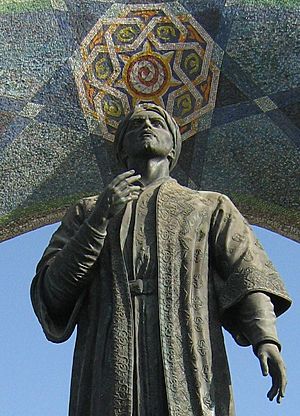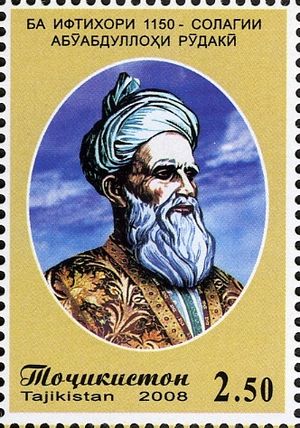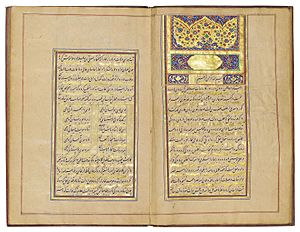Rudaki facts for kids
Quick facts for kids
Rudaki
|
|
|---|---|

Statue of Rudaki in Dushanbe, Tajikistan
|
|
| Born | c. 858 Banoj, Samanid Empire |
| Died | 940/41 (aged 82 or 83) Banoj, Samanid Empire |
| Occupation |
|
Rudaki (born 858 – died 940/41) was a famous Persian poet, singer, and musician. He worked as a special poet for the rulers of the Samanid Empire. Many people see him as the very first important poet to write in a language called New Persian.
Rudaki is thought to have written over 180,000 lines of poetry. Sadly, only a small part of his work still exists today. One of his most famous surviving works is a small piece of his poetic version of Kalila wa-Dimna. This is a collection of old Indian fables, which are like short stories with a moral lesson.
Rudaki was born in a village called Banoj, which is now in the Rudak area. Most of his important career happened at the Samanid court. He worked for the Samanid ruler, or amir, Nasr II (who ruled from 914 to 943). He might have even started working there earlier, under Nasr II's father, Ahmad Samani (who ruled from 907 to 914).
Rudaki's success was greatly helped by his main supporter, a powerful official called Abu'l-Fadl al-Bal'ami. Bal'ami was a vizier, which means a high-ranking advisor or minister. He played a big role in helping New Persian literature become popular in the 900s. After Bal'ami lost his power in 937, Rudaki's career also went downhill. He was eventually removed from the court. He spent his last years living in poverty. He died blind and alone in his hometown.
In Iran, Rudaki is known as the "founder of New Persian poetry." In Tajikistan, he is called the "father of Tajik literature."
Contents
Who Was Rudaki?
Rudaki's full name was Abu Abd Allah Ja'far ibn Muhammad ibn Hakim ibn Abd al-Rahman ibn Adam al-Rudhaki al-Sha'ir al-Samarqandi. His name is sometimes spelled "Rodaki" or "Rōdhakī."
His Early Life and Background
We don't know a lot about Rudaki's early life. Most of what we know comes from clues in his own poems. He lived during the time of the Samanid Empire (819–999). This was a period when New Persian literature really started to grow and become popular.
Rudaki was born around 858 in the village of Banoj. This village is located in the Rudak area, between the cities of Samarqand and Bukhara. Many early poets and historians wrote that Rudaki was blind. Some modern experts wonder if he was born blind. This is because his poems describe nature so vividly, as if he could see it clearly.
Besides being a poet, Rudaki was also a singer and a musician. For a long time in Persian history, poems were often sung as part of music. The language used in official and literary works before this time was called Middle Persian. After the Muslims conquered Iran, the language changed. It became what we now call New Persian.
His Career at Court
By the age of eight, Rudaki had reportedly memorized the entire Qur'an, which is the holy book of Islam. He was also very skilled at writing poetry. A famous musician named Abu'l-Abak Bakhtiar taught him how to play the chang, a type of harp.
In his younger years, Rudaki became very popular. People loved his beautiful voice, his amazing poems, and his skill with the chang. Records show that Rudaki worked for the Samanid ruler, Nasr II (who ruled from 914 to 943). He also worked closely with Nasr II's vizier, Abu'l-Fadl al-Bal'ami. Some experts believe Rudaki might have even started working for the Samanid court earlier. This could have been under Nasr II's father, Ahmad Samani (who ruled from 907 to 914). One of Rudaki's poems seems to comfort Ahmad Samani after his father died in 907.
Rudaki's time at the Samanid court was the most important part of his life. Being a court poet was more than just entertaining people. It was a very important job in the Persian court. An ancient Persian king, Ardashir I, once said that a poet was "part of government." Poets were expected to praise the ruler and his land. They also gave advice and moral guidance. This means Rudaki was likely very good at giving wise counsel.
Rudaki's success was largely thanks to his main supporter, Bal'ami. Bal'ami was a key figure in the growth of Persian literature in the 900s. He believed Rudaki was the best poet among both Persian and Arab writers.
Rudaki was also a close friend of his student, Shahid Balkhi. Balkhi was a leading poet and scholar in the Samanid Empire. When Shahid Balkhi died in 936, Rudaki wrote a sad poem, called an elegy, in his memory.
Rudaki's career began to decline after Bal'ami lost his power in 937. Rudaki soon fell out of favor with the ruler and was dismissed from the court. He spent his last years living in poverty. He died blind and alone in his hometown in 940 or 941.
What He Wrote
According to a writer named Asadi Tusi, Rudaki's divan (a collection of short poems) had over 180,000 lines. However, most of it has been lost over time. The small amount of Rudaki's writing that remains, mostly single lines, can be found in old Persian dictionaries.
A few complete poems have survived. One important one is a qasida, which is a long poem of praise or an ode. This qasida has almost 100 lines. It was dedicated to Abu Ja'far Ahmad ibn Muhammad, who governed the region of Sistan from 923 to 963. In this poem, Rudaki calls Abu Ja'far a noble person from an old Persian family. He also calls him the "pride of Iran." This shows that people felt a strong connection to their Iranian identity, even after the Samanid period. For this poem, Abu Ja'far rewarded Rudaki with 10,000 dinars, which was a lot of money.
Rudaki's most famous work is his poetic version of Kalila wa-Dimna. This book is a collection of fables from India. The ruler Nasr II had ordered his vizier Bal'ami to translate the book from Arabic into Persian. Then, "interpreters" would read it aloud to Rudaki, who was blind, so he could turn it into poetry. Only a few of Rudaki's verses from this work have survived.
Rudaki's surviving poems are usually easy for people who read Persian to understand. Even though some words and phrases are old, the meaning is clear.
Rudaki's poems were mostly about everyday life and human feelings. Even though Islam was well-established by the 900s, Persians still remembered their ancient Zoroastrian history. Rudaki often wrote about old Iranian ideas instead of just Muslim ones. Some of his poems were written in an old style called andarz. This style offered ethical teachings, friendly criticism, and advice on how to behave well.
His Lasting Impact

Rudaki is seen as the first major poet to write in New Persian. While other poets wrote in New Persian before him, like Abu Hafs Sughdi, most of their work has not survived. In Iran, Rudaki is known as the "founder of New Persian poetry." In Tajikistan, he is called the "father of Tajik literature." These two titles are not contradictory, meaning they both make sense.
Rudaki's life was shown in a 1957 film called A Poet's Fate. The next year, a play about him called Rudaki was written. This was the first play about a real person in Tajik history.
In 1958, Iran and the Tajik Soviet Socialist Republic celebrated the 1100th anniversary of Rudaki's birth. They held a big meeting with many important scholars. During this time, Rudaki's burial place in Panjrud was found. A Soviet archaeologist and anthropologist named Mikhail Mikhaylovich Gerasimov studied Rudaki's remains. He even used them to create a sculpture of Rudaki's face. After the Soviet Union broke apart, Rudaki became an even stronger symbol of Tajik identity. He also helped show their connection to other Persian-speaking countries.
Many experts agree that Rudaki started a new and important time for Persian writing. One expert, Francois de Blois, said Rudaki "was the most celebrated Persian poet prior to Ferdowsi." After his death, Rudaki remained very popular for about 200 years. However, during the Mongol period, he became less popular among the new poets. Still, he was not forgotten. Some later works even used his name, though they were mostly written by others.
In the 1800s, Rudaki became popular again, along with other old poets from the Khurasan region.
See also
 In Spanish: Rudakí para niños
In Spanish: Rudakí para niños



